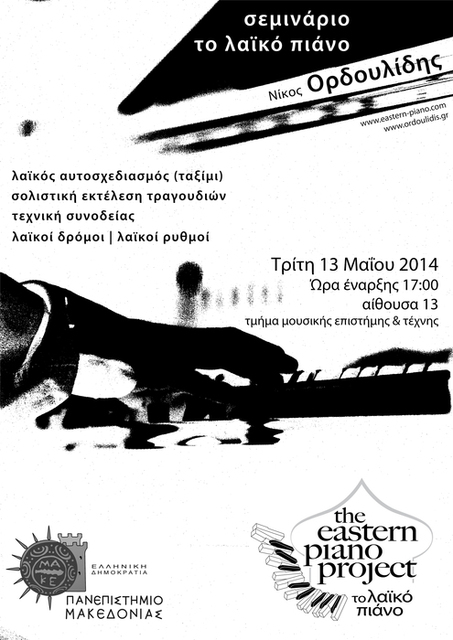Seminar University of Macedonia
A seminar on the popular piano at the University of Macedonia | Tuesday 13 May 2014
--
The piano as a musical instrument has existed on music stages as well as in the discography of the rebetiko and neo-popular urban music for many years. The names of certain pianists of this particular repertoire have been linked to the instrument, bequeathing recorded material of great musical value. Despite this, no publication (academic or otherwise) has been found that refers to this huge and extremely important issue, that is, the role of the piano in urban popular music. The primary purposes of the whole enterprise are two: a) to show techniques with which the instrument can be transformed from an accompaniment or semi-accompaniment into a solo and b) to show various accompanying techniques and in general the role of the instrument in a popular orchestra. These two purposes stem from two general personal desires: to research the issue of the popular piano in depth, and for this research to constitute a foundation for future research by new students, having as a higher purpose the acknowledgement of popular music by the global educational system (including that of Greece), the instruments, the theory, the repertoire and whatever else it entails. It must be stressed that this enterprise does not only concern the Greek repertoire, even though it is based on it; it may function as a reference point and manual for various Eastern musical traditions where the piano participates or can participate in an orchestra. This occurs due to the fact that two fundamental elements of the Greek popular, that is the dromi and the rhythms utilized, are closely linked to those of other Eastern musical cultures.
The course of the seminar lectures which has begun (Municipal Conservatory of Florina, 2013; State Conservatory of Thessaloniki, 2014) brings music students, pianists and music fans into initial contact with the issue. Especial emphasis is given to popular improvisation, what is called ‘taksimi’ by popular musicians, and the ways in which it can be performed on the piano. Furthermore, using examples of songs from different periods of the so-called ‘rebetiko’, ways in which songs of diverse aesthetic can be rendered on the piano are analyzed. The way in which the instrument can ‘behave’ in a popular orchestra is another part of the seminars, presenting alternative accompaniments, according to the situations which the musician may face. Finally, the popular dromi and the popular rhythms, extremely important chapters in Greek urban popular music, are analyzed either in general, or based on their utilization on the piano.
